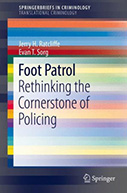Foot Patrol: Rethinking The Cornerstone Of Policing

Authors: Jerry H. Ratcliffe and Evan T. Sorg
Publisher: Cham: Springer, 2017. 87p.
Reviewer: Michael S. Scott | March 2018
Foot Patrol: Rethinking the Cornerstone of Policing is one in the Springer Publishing company’s SpringerBriefs Translational Criminology series whose aim is to inform researchers and practitioners alike about important research and practice in criminology and criminal justice. To put this work into context, the Translational Criminology series is a subseries of the SpringerBriefs Criminology series which is but one of 84 SpringerBriefs topical areas. In short, it is part of a sizable body of publications synthesizing knowledge across a very wide range of fields. Somewhat curiously, there is also a Policing subseries that appears to focus on police administrative issues, seemingly deferring substantive policing issues to the Translational Criminology subseries. This apparent ambiguity as to where a topic such as police foot patrol belongs in the taxonomy of knowledge might well reflect persistent ambiguity about the nature of the police function, or where the concerns of policing begin and end.
Setting aside for the moment questions about where foot patrol belongs in a conceptual framework, this brief is rich with facts and insights about the historical and modern adoption of police foot patrol. The authors are among the steadily growing number of those with feet in both the worlds of policing and academia. Both authors started their careers as police officers, one in London, the other in New York City, and both also did time as foot patrol officers. They both then earned doctorates and now specialize in research and teaching about crime and policing. Their backgrounds almost uniquely qualify them to write a brief that integrates research and practical knowledge about foot patrol. (And I can claim the same qualification—as a current academic with prior experience as a foot-patrol officer—to review what they’ve written.)
In tracing the historical development of foot patrol—from the time when it was nearly the only patrol option—the authors astutely point out that foot patrol has alternately, and sometimes simultaneously, served two basic social purposes, one to please the public and the other to reduce crime and disorder — one for show, one for effect. They then wisely encourage police administrators and researchers to be clear about which purpose is of the highest priority because much about the management and study of foot patrol depends heavily upon its principal aim, a seemingly self-evident truth that is often forgotten.
The authors also summarize some of the research into general police effectiveness and the particular effects of foot patrol. The largest portion of the brief is devoted to describing and discussing two recent experimental-design studies of foot patrol in Philadelphia, Pennsylvania in which the authors were researchers. In making the jump, however, from the history of foot patrol (going back to ancient Greece and Rome) to the present, the authors skipped over some important modern experiences. While the authors do take account of the studies of foot patrol in Newark, New Jersey and Flint, Michigan in the 1980s, they either omitted or didn’t quite capture the essence of such 1980-90s-era foot-patrol-related initiatives as the ones in New York City (the Community Patrol Officer Program), Houston (Citizen Contact Patrols), Baltimore County, Maryland (the COPE units), and Edmonton, Alberta (the Edmonton Neighborhood Foot Patrol). The point is not to quibble about the comprehensiveness of a literature review, as this brief did not set out to conduct one, but to make the more substantive point that some of these other foot-patrol initiatives were purposely designed so as to make the foot-patrol officers effective community problem solvers, and not merely “crowd pleasers.” Given the authors’ strong interest in understanding whether foot patrol can not only please the public, but effectively address crime and disorder as well, some greater attention to the lessons learned from efforts purposely directed toward this goal would have been useful. Even the authors’ special interest in Philadelphia, about which they assert that the police there had little experience with problem-oriented policing, neglects the considerable effort Philadelphia police made in the late 1980s-early 1990s to adopt a problem-oriented policing approach (targeted in its South division), albeit not exclusively via foot patrol.
Perhaps the richest chapter in the book is titled “The Foot Beat Experience” in which the authors, drawing heavily from their experience, explain the contextual nuances and complexity of policing a community on foot. It is here that the authors best bust the myth that foot patrol is a ministerial function in which police officers merely deter misconduct through their physical presence. Ratcliffe and Sorg describe the craft aspects of policing on foot that are hard, if not impossible, to quantify for research purposes: the nature and quality of the interactions with members of the public, the discretionary decision-making of officers, the way in which officers understand their mission, the social values that inform officers’ work, and the relative capacity of officers for complex problem solving in complex and often ambiguous social environments. In doing so, the authors help make the hugely important point that what genuinely matters to good policing is not the police mode of transportation (car, foot, bicycle, horse), but what police officers actually do in identifying, prioritizing, understanding, and resolving the nearly infinite variety of complex problems with which they are confronted.
With a solid grasp of the research literature and rich personal experiences in foot patrol, the authors make clear that the potential for policing on foot is far greater than many police agencies have been able to realize, but that tapping that potential is much less a matter of what officers do with their feet than what they do with their minds. Not fully explored in this book then is what ought to be done by police administrators to develop in their officers a greater capacity for understanding the policing problems in the communities in which they work, and developing and implementing responses that are both fair and effective.
And this brings me back to my earlier, seemingly inconsequential, concern about whether a book on police foot patrol properly belonged in a translational criminology series. The authors conclude their discussion, as all trained scholars do, with an urging for more research into the effectiveness of foot patrol. This recommendation is consistent with much in the evidence-based policing/translational criminology approach; it seeks to better understand whether particular policing tactics—of which foot patrol is one— “work” or “don’t work.” The authors actually make the argument throughout their brief, but don’t state it explicitly, that asking whether foot patrol “works” is asking the wrong question, or more profoundly, that it is thinking about the matter in the wrong way. If foot patrol is the “cornerstone of policing,” as the brief’s title asserts, then we have laid the wrong cornerstone. No method of patrol, indeed no tactic, should be the cornerstone of policing. A cornerstone is the thing around which the rest of an edifice is built. In policing the cornerstone must be the mission of police, its fundamental goals or aims, not the tactics or means employed for achieving them. Understanding foot patrol is important, but it is better to try to understand it in the context of the specific crime and disorder problems that police are addressing, rather than in the abstract. Asking whether foot patrol is effective in policing is like asking whether surgery is effective in medicine. The answer surely is that it depends on the problem for which you are using it. Surgery is possibly effective for an inflamed gall bladder, but almost certainly not for influenza. Foot patrol is possibly effective for addressing street prostitution problems, but almost certainly not for child abuse.
Much of the tension that Ratcliffe and Sorg describe between police officers who see research as irrelevant to police practice and researchers who see police officers as intransigent and unappreciative of the wisdom of research, has wider implications for the ways in which research can properly inform police practice. It may be that as much as street cops resent their superiors micro-managing their activities and failing to trust officers’ own judgments about how to police, they similarly resent researchers doing likewise through controlled experiments. Police officers who see themselves as professionals, like their counterparts in other professions, prefer to be in the driver’s seat in identifying and diagnosing the problems that comprise their work, and then using research findings about “what works” to guide, but not dictate, how they respond to the problem. This leaves to their good judgment how best to integrate various tactics, and at what “dosages,” taking account of all manner of contextual factors, and assessing the results in terms that make sense to them and to those affected by the problem. Indeed, what the authors wind up describing and advocating in this brief is a nuanced, flexible form of policing that embraces the principles and methods of problem-oriented policing and community policing, and that in some respects is the antithesis of both the standard model of deterrence-based policing and a strict form of evidence-based policing.
Research can surely help police to be more effective and more professional, and the sort of studies of foot patrol described in this book contribute to that end. As police continue their long march toward truly professional policing, researchers can accompany them, but can’t put them on a forced march, a point that the authors make well here.
Michael S. Scott, Clinical Professor, Arizona State University, School of Criminology & Criminal Justice


